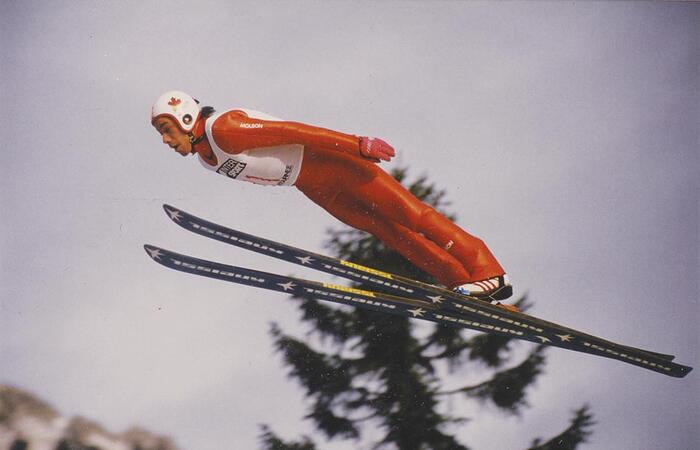While some people may not enjoy the sight of snowflakes falling to the ground, skiers don’t think about the shoveling that is to follow, but rather relish in the thought of hitting the slopes and trails of our local skiing facilities.
While the origins of the ski have been traced back thousands of years, the introduction of skiing as a sport are thought to have begun in Norway in the 1830s, with written rules for competitions established in the 1880s. It was the influence of immigrants from Nordic countries that is credited with introducing the sport to Canada with early competitions featuring the nordic events of both cross country racing and jumping.
By the turn of the last century skiing had gained in popularity with many Canadian towns having their own ski jumps. Our community was no exception with a 1907 report of a group of local skiing enthusiasts inviting people to a skiing exhibition near the old Shuniah Mine with 200 people making their way to the event on skis, snowshoe and by horse and rig. The club featured a small ski-hut and a scaffold for ski jumping and continued to be used up until the early 1920s.
In 1929 the Port Arthur Ski Club established a location on the ridge running above Strathcona Golf Course, just off of Hodder Avenue, known as Strathcona Heights. The club members spent the summer clearing brush and building the trestle for a jump out of logs from the site. A clubhouse was built with a road established to access the chalet, with skiers also travelling to the hill via the local trolley. The 1930s saw the construction of a new jump and the installation of electric lights on the slopes and in the clubhouse. Night hikes along the trails were made possible with illumination by coal-oil torches.
Located five miles north of Strathcona on a burned over area, the development of Mount Baldy can be traced back to the winter of 1933-34 when some members of the PASC thought it would be a good place to create some downhill ski runs and eventually a trail was cut from the PASC Strathcona location to the foot of Baldy. The group continued to work on the site, adding a tar-paper shack, followed by a log clubhouse. In 1935 the first downhill run was cut and the following year a slalom trail was developed.
In 1946 the PASC took over the operation of Mount Baldy and continued to develop it, building a road which allowed people to drive to the hill and installing a long rope-tow. By 1951 the Club hosted their first major ski meet, the Central Canadian Championships and in 1954 were home to the National Junior Ski Championships. During the 1960s the Spiess family took over the operation of the facility, continuing to do so until just recently with the Kardas family now at the helm of the resort.
Not to be outdone by their neighbours, skiers in Fort William also enjoyed a rich history on the snow. While early attempts to secure a spot at Mount McKay were unsuccessful, by 1912 a site was established at King George’s Park which was located on the north bank of the Kaministiquia River. Building a clubhouse and jumping scaffolding, they hosted their first competition in 1913. The location, however, was short lived with the south facing exposure proving incapable of producing suitable snow conditions.
Another location was found which was not one normally utilized by the public for sporting activities. Through the efforts of the Superintendent of the Prison Farm, and local skiing enthusiasts, two jumps were built at the jail and a ski meet was held featuring ski-jumping and cross-country events. One report indicated that the facility was designed with the help of a prisoner who was a former expert skier.
In 1929 the Fort William Ski Club was officially formed and established itself at Hawke’s Farm, situated a few miles out of the city on the south side of the Kam River. The club members cleared the land, built a scaffold and renovated the old farmhouse to serve as a clubhouse. With the sale of the property in 1932, the club signed a lease with the Fort William First Nation for a site near Mount McKay where they would remain for more than fifty years.
In 1939 the FWSC hosted the area’s first ever Canadian Ski Championships. In preparation for this historic event a 165m jump was built, a new ski tow was erected, and a new course and clubhouse were created. Competitors attended the event from all across Canada, the US and Norway, and the Toronto Star Weekly dubbed Fort William the future St. Moritz of Canada. A decade later the club hosted the cross-country and jumping portions of the national championships and as it moved into the 1950s it continued to develop and grow, providing many more years of enjoyment for the local skiing community into the 1980s.
During the 1950s another Fort William ski area was developed when Bill Irwin, a 1948 Olympian, founded Loch Lomond. Going on to own and operate it for the next twenty-three years, the facility served as a great training ground for many local skiers, including his son, Dave Irwin, who went on to become a member of the legendary Crazy Canucks.
The 1960s saw the development of Little Norway Ski Resort by the Hansen’s, a long-time local skiing family, which eventually became Sundance and in 1975 transitioned into Big Thunder National Ski Training Centre, which ushered in a new era for skiing in the area. Throughout its over 20-year history, Big Thunder hosted a number of World Cup events and played host to the world at the 1995 Nordic World Ski Championships.
The 1960s also saw an increase in cross-country skiing thanks to the efforts of such groups as the Finnish Reipas Club which hosted the 1960 Canadian cross-country championships at Intola and the 1965 nationals at Boulevard Lake and many races at their trails at Tapiola and at Centennial Park. The ensuing years saw the formation of the Thunder Bay Ski Club, the forerunner to the Big Thunder Nordic Ski Club, and individuals such as Reijo Puiras develop the Lappe Nordic Centre, and organizations like the Thunder Bay Nordic Trails Association provide access to trails at the Kamview Nordic Centre, Kakabeka Falls and Sleeping Giant Provincial parks. The creation of the National Team Development Centre in the 1990s has provided our nation’s top young skiers the opportunity to hone their skills on our local trails.
While skiing has changed a great deal since those early days at Shuniah Mines, it continues to serve as a wonderful way to enjoy our winter wonderland. At the core of our communities rich and proud skiing history are the volunteers of yesteryear and today who have not only provided skiing opportunities for local citizens but they have also helped produce world-class athletes and sport administrators who have represented our community with pride and distinction from the national to the Olympic level.













